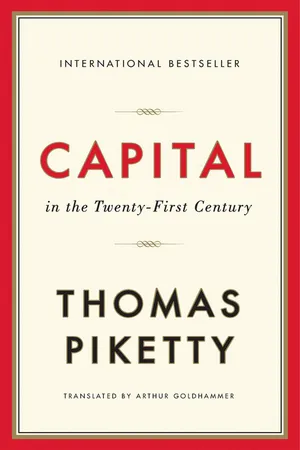
- English
- ePUB (mobile friendly)
- Available on iOS & Android
Capital in the Twenty-First Century
About this book
A New York Times #1 Bestseller
A Wall Street Journal #1 Bestseller
A USA Today Bestseller
A Sunday Times Bestseller
A Guardian Best Book of the 21st Century
Winner of the Financial Times and McKinsey Business Book of the Year Award
Winner of the British Academy Medal
Finalist, National Book Critics Circle Award
"It seems safe to say that Capital in the Twenty-First Century, the magnum opus of the French economist Thomas Piketty, will be the most important economics book of the year—and maybe of the decade."
—Paul Krugman, New York Times
"The book aims to revolutionize the way people think about the economic history of the past two centuries. It may well manage the feat."
—The Economist
"Piketty's Capital in the Twenty-First Century is an intellectual tour de force, a triumph of economic history over the theoretical, mathematical modeling that has come to dominate the economics profession in recent years."
—Steven Pearlstein, Washington Post
"Piketty has written an extraordinarily important book…In its scale and sweep it brings us back to the founders of political economy."
—Martin Wolf, Financial Times
"A sweeping account of rising inequality…Piketty has written a book that nobody interested in a defining issue of our era can afford to ignore."
—John Cassidy, New Yorker
"Stands a fair chance of becoming the most influential work of economics yet published in our young century. It is the most important study of inequality in over fifty years."
—Timothy Shenk, The Nation
Frequently asked questions
- Essential is ideal for learners and professionals who enjoy exploring a wide range of subjects. Access the Essential Library with 800,000+ trusted titles and best-sellers across business, personal growth, and the humanities. Includes unlimited reading time and Standard Read Aloud voice.
- Complete: Perfect for advanced learners and researchers needing full, unrestricted access. Unlock 1.4M+ books across hundreds of subjects, including academic and specialized titles. The Complete Plan also includes advanced features like Premium Read Aloud and Research Assistant.
Please note we cannot support devices running on iOS 13 and Android 7 or earlier. Learn more about using the app.
Information
PART ONE
INCOME AND CAPITAL
{ ONE }
Income and Output
The Capital-Labor Split in the Long Run: Not So Stable
Table of contents
- Cover
- Title Page
- Copyright
- Contents
- Acknowledgments
- Note on the Text
- Introduction
- Part One: Income and Capital
- Part Two: The Dynamics of the Capital/Income Ratio
- Part Three: The Structure of Inequality
- Part Four: Regulating Capital in the Twenty-First Century
- Conclusion
- Contents in Detail
- List of Tables and Illustrations
- Index